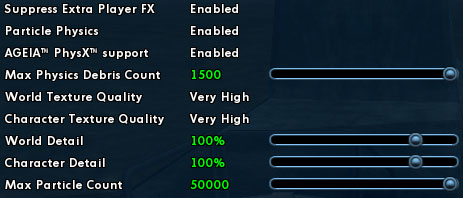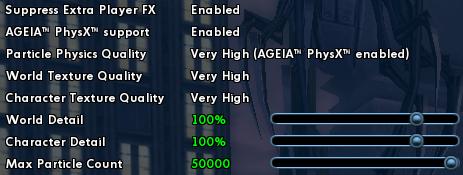PhysX Performance Update: City of Villains
by Ryan Smith on September 7, 2006 6:00 AM EST- Posted in
- GPUs
The last time we took a look at physics performance under City of Villains utilizing a PhysX card, the code was still in beta, and the results for the PhysX card were lackluster at best. What we found was that while utilizing a PhysX card did indeed enable CoV to generate a good deal of extra eye-candy, the cost came at an immense performance drop, especially to minimum framerates. At the time, AGEIA had promised that performance under CoV would improve between then and when the improvements were actually put into the Issue 7 patch. That patch has since shipped, and we are back to take a look at just what the PhysX card is capable of doing given more refined code.
Since the beta version of Issue 7 was in testing, Cryptic has also made several changes to CoV to better allow benchmarking, as previously FRAPS was the only way to do a repeatable test using higher physics settings. The CoV's benchmark mode now properly renders additional physics based on the game's settings, allowing for more controlled testing and more importantly testing against the live server where we can no longer copy characters. Also, the highest physics mode, previously only allowed with PhysX hardware installed, now can run completely under software, giving true apples-to-apples testing where all physics effects are the same.


This later point is particularly important, since AGEIA was able to confirm a few earlier theories we had on the game. In the highest quality mode (various physics modes have replaced the items slider), both the hardware and software physics engines end up doing the same physics routines with the same precise formulas. Meanwhile, in any of the lower quality modes the software engine is allowed to make approximations in return for the faster calculations, and at the lowest quality settings the software mode renders fewer overall effects. We'll look at how the various settings affect the performance and visual quality under CoV, so keep in mind that only the maximum quality mode is identical for both software and hardware physics.
Dual core performance is also something that has seen some changes since the Issue 7 beta, as the game is now capable of doing physics calculations on a separate core. As we'll see in a second, the game benefits tremendously from a second core, which may not be in AGEIA's best interests.
What does all of this mean for physics performance then under CoV? Let's take a look.
Since the beta version of Issue 7 was in testing, Cryptic has also made several changes to CoV to better allow benchmarking, as previously FRAPS was the only way to do a repeatable test using higher physics settings. The CoV's benchmark mode now properly renders additional physics based on the game's settings, allowing for more controlled testing and more importantly testing against the live server where we can no longer copy characters. Also, the highest physics mode, previously only allowed with PhysX hardware installed, now can run completely under software, giving true apples-to-apples testing where all physics effects are the same.


This later point is particularly important, since AGEIA was able to confirm a few earlier theories we had on the game. In the highest quality mode (various physics modes have replaced the items slider), both the hardware and software physics engines end up doing the same physics routines with the same precise formulas. Meanwhile, in any of the lower quality modes the software engine is allowed to make approximations in return for the faster calculations, and at the lowest quality settings the software mode renders fewer overall effects. We'll look at how the various settings affect the performance and visual quality under CoV, so keep in mind that only the maximum quality mode is identical for both software and hardware physics.
Dual core performance is also something that has seen some changes since the Issue 7 beta, as the game is now capable of doing physics calculations on a separate core. As we'll see in a second, the game benefits tremendously from a second core, which may not be in AGEIA's best interests.
What does all of this mean for physics performance then under CoV? Let's take a look.










31 Comments
View All Comments
shank15217 - Saturday, September 16, 2006 - link
All this review shows is how good the AGEIA software engine is capable of using a second core to it's full advantage. Infact their goals are slightly two sided. Its true the hardware is probably a magnitude faster than cpus but cpus are reaching 4 core and beyond with shared caches and very wide busses. Unless AGEIA puts their hardware implementation on a PCI Express / HTX slot its not gonna outrun even a 4 core core 2 duo or an athlon 64 for that matter.Vergil - Monday, September 11, 2006 - link
Ageia's PPU should be integrated with the motherboard to for maximum results ladies and gentzCan you imagine having the raw horsepower of a motherboard with a local GPU thats powerful as a 7800 GTX? Local components work better with any CPU(meaning have a better data transfer/flow rate) than any serial bus. Motherboard bus speeds(PCI/AGP/PCIe) limit the performance of most video & other cards(even the high end ones) to some degree. However, PCI-e is the next best thing without having it on the die with the CPU. But with chipsets that help with physics, it has to catch it BEFORE it hits the CPU, which is why there is a major performance hits to City of Villians. The CPU has to collect all of the data before everything else gets it providing thats its not integrated. Then it has th elaborious task of dealing with data it isnt prepared to use.
soulshagga - Saturday, September 9, 2006 - link
The author obviously hasn't written a physics engine before.The problem is n! in complexity -- the reason being is each entity interacts with each other. You can't just blindly update n entities independently of each other (consider collision detection for instance).
I won't elaborate here because it is beyond the scope of this article, not to mention these forum posts, but just think about what would happen if you just blindly update the physical attributes of n entities... you would lose information. If you don't get what I'm saying, don't worry about it -- just take my word for it. :)
Please, don't make bold statements like that if you are unsure.
Thanks.
ojingoh - Thursday, September 7, 2006 - link
sorry for the confusion -- i see you in fact did run the game unacellerated, thanks for thatojingoh - Thursday, September 7, 2006 - link
what i meant by the minimum physics -- this card does physical calculations, not just particles. things like collisions and deformations etc.ojingoh - Thursday, September 7, 2006 - link
i have an issue with your review. your testing doesnt include screenshots of the things tested.please explain "slightly lower quality physics mode" -- what setting was this? 75%? 50%? without screenshots it's hard to identify what you claim. the slider states "up to" implying that some frames will have the maximum but some have far less. is it hard to tell the diffrence between 500 and 1000 particles? what would be a reasonable number of particles?
also you exclude any test showing what happens when you have the card installed but run the game at minimum phisics, i think in cov it's 100 particles (idk if this is the case, this is also not tested.)
Regs - Thursday, September 7, 2006 - link
Dual core actually helps physics processing? I guess this is only in games that support dual core.PrinceGaz - Friday, September 8, 2006 - link
I imagine that most games which have support for offloading work to the PhysX card will also support offloading the same work to a seperate "software-physics" thread. If they've already made the effort to seperate the physics work from the main application so it can be sent to the PhysX card, it should be trivial to run that work in a second (or multiple) threads. Therefore games that make use of the PhysX card will most likely also be able to use a dual-core processor to good effect, as is the case with CoV.Calin - Friday, September 8, 2006 - link
I assume more games support dual cores than PPU right now (and the trend probably favours the dual cores rather than the PPU)Anyway, a dual core will help with short processor-intensive (even if very short) tasks that appear "out of the blue" - antivirus, some operating system tasks/schedules/other activities
Missing Ghost - Thursday, September 7, 2006 - link
As soon as there is a PCIe 1x/4x version available, I will buy it.